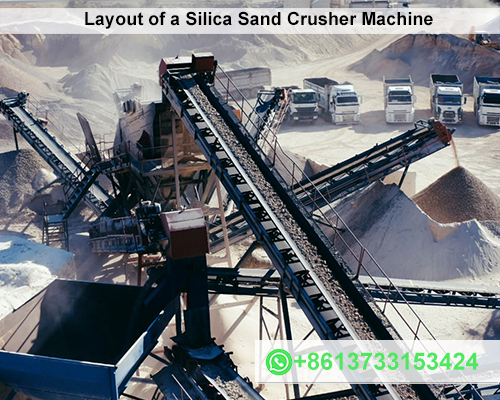Layout of a Silica Sand Crusher Machine
The layout of a silica sand crusher machine is critical to the efficiency and performance of the crushing process. Silica sand, known for its hardness and fine grain size, requires specialized crushing equipment and a well-thought-out design to ensure maximum productivity while minimizing operational costs. In this article, we explore the essential aspects of designing an optimal layout for a silica sand crusher machine.
Understanding Silica Sand and Its Applications
Silica sand, primarily composed of silicon dioxide (SiO₂), is widely used in various industries such as glassmaking, construction, foundries, and filtration. Due to its hardness and uniform grain size, it requires specific crushing and screening processes to meet industry standards.

Components of a Silica Sand Crushing Layout
An efficient silica sand crusher machine layout integrates several components, each with a distinct role in the crushing process:
- Feeding System
- Hopper and Vibratory Feeder: Ensures uniform feeding of silica sand into the crusher, preventing blockages and ensuring smooth operation.
- Design Consideration: The hopper size must accommodate the required feed volume, while the feeder should minimize spillage.
- Primary Crusher
- Jaw Crusher or Gyratory Crusher: Used for initial size reduction of raw silica sand.
- Selection Criteria: Choose a crusher with high capacity and wear-resistant materials to handle silica’s abrasive nature.
- Secondary Crusher
- Impact Crusher or Cone Crusher: Reduces silica sand to finer sizes.
- Advantages: Impact crushers are suitable for shaping, while cone crushers ensure consistent particle sizes.
- Screening System
- Vibratory Screens: Separate silica sand into various sizes based on industry requirements.
- Configuration: Multi-layer screens can improve efficiency by simultaneously separating multiple grades of sand.
- Conveyors and Transfer Points
- Conveyor Belts: Transport materials between different stages.
- Design Tip: Use dust suppression systems at transfer points to minimize airborne silica particles.
- Dust Collection System
- Bag Filters and Cyclones: Essential for capturing fine silica particles and maintaining compliance with environmental standards.
Key Factors in Designing the Layout
- Space Optimization
- Ensure sufficient space between components for easy maintenance and troubleshooting.
- Use vertical stacking to save ground area if space is limited.
- Material Flow
- Design a layout that minimizes backflows or bottlenecks, ensuring a continuous and efficient crushing process.
- Optimize conveyor angles to prevent material spillage.
- Power and Energy Efficiency
- Use energy-efficient motors and variable frequency drives (VFDs) to reduce operational costs.
- Position equipment strategically to minimize power losses during material transfer.
- Safety Measures
- Install guards and barriers around moving parts.
- Incorporate emergency stop systems and fire suppression systems in critical areas.
- Scalability
- Design the layout with future expansion in mind to accommodate increased production demands.
Example Layout for a Silica Sand Crusher
- Raw Material Hopper → 2. Vibratory Feeder → 3. Primary Crusher (Jaw Crusher) → 4. Conveyor to Secondary Crusher (Impact Crusher) → 5. Screening Unit → 6. Stockpiles or Final Output Conveyor
This simple linear layout can be adjusted to include additional screening or washing units based on the specific requirements of the silica sand.
Challenges in Silica Sand Crushing
- Abrasion and Wear: Silica’s hardness can cause rapid wear of crusher parts. Use high-quality, wear-resistant materials for key components.
- Dust Control: Fine silica dust can pose health and environmental risks. Employ effective dust suppression systems.
- Moisture Content: Wet silica sand can clog screens and feeders. Incorporate drainage or drying systems if necessary.
Conclusion
A well-designed silica sand crusher machine layout is essential for achieving high productivity, low operational costs, and compliance with environmental regulations. By carefully considering factors such as space, material flow, and safety, operators can optimize their crushing process to meet the demands of various industries. Investing in a thoughtful layout not only enhances efficiency but also ensures the longevity of the equipment, making it a cornerstone of any silica sand production facility.









